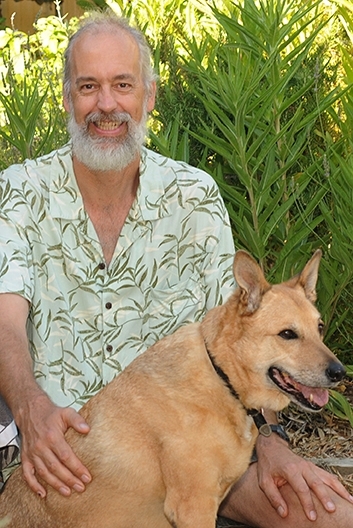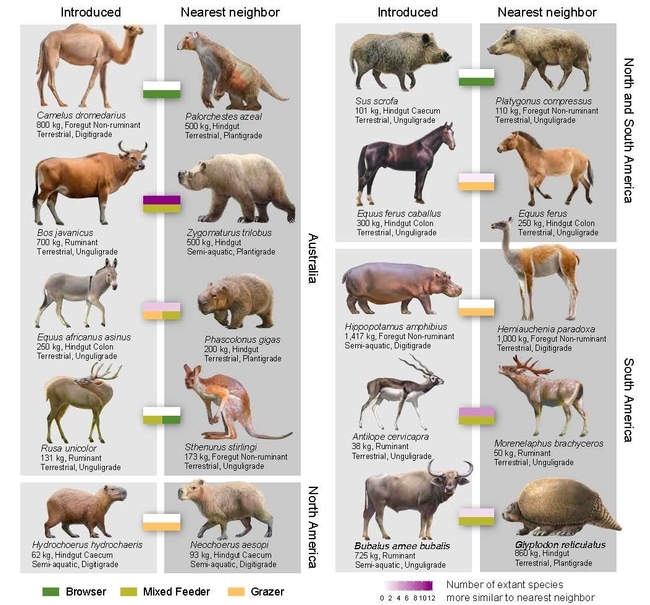
If you've been reading The New York Times, Washington Post, Los Angeles Times, and National Geographic, you know about this.
And about the newly published research paper, “Introduced Herbivores Restore Late Pleistocene Ecological Functions” in the Proceedings of the National Academy of Sciences (PNAS).
It's the work of an 11-member international team led by Australian ecologist Erick Lundgren of the University of Technology, Sydney. The co-authors include evolutionary biologist Scott Carroll of the UC Davis Department of Entomology and Nematology.
Out-of-place and troublesome species, such as hippos, feral hogs, wild horses and burros, may actually be restoring the ecological services of extinct animals, the ecologists said.
The authors pored over scientific literature; created a list of living and extinct herbivores over the last 126,000 years; and categorized them by their body size, anatomy, habitat, diet, and how their bodies digested the vegetation. Then they compared their lifestyles in overlapping regions.
One of the studies dealt with the abandoned hippos of Colombian drug lord Pablo Escobar (1949-1993), who purchased a male and three females in the 1980s from a California zoo and kept them in fields along the Magdalena River, northwestern Colombia. Without humans and other predators decimating them, the population today is 80 to 100 and is expected to reach 800 to 5000 by 2050.
The out-of-place hippos may be filling the exotic roles of extinct massive animals, such as giant llamas and rhinoceros-sized relatives, the ecologists related.
Said Carroll: “That paleontological analysis found that, amazingly, introduced herbivores– including Pablo Escobar's escaped Colombian hippos– often match the functional traits of extinct natives better than do those missing species' closest living native relatives. In this way, the ‘out-of-place' make the world more similar to the pre-extinction past. The ‘shoot-first- and-ask-questions later' approach as a maxim is as reckless as it sounds, and it's not going to sustain our life-saving drugs, nor the species we revere or ecosystems we rely on, into the future.”
“Many introduced herbivores restore trait combinations that have the capacity to influence ecosystem processes, such as wildfire and shrub expansion in drylands,” the team wrote.
As for feral hogs in North America, Carroll said their rooting increases tree growth and attracts bird flocks, like the ecological work of their extinct ancestors. Likewise, the feral horses and burros, known for their well-digging behavior, are replacing the original American horses, which went extinct 12,000 years ago.
In their abstract, the authors pointed out that humans “have caused extinctions of large-bodied mammalian herbivores over the past 100,000 years, leading to cascading changes in ecosystems. Conversely, introductions of herbivores have, in part, numerically compensated for extinction losses. However, the net outcome of the twin anthropogenic forces of extinction and introduction on herbivore assemblages has remained unknown. We found that a primary outcome of introductions has been the reintroduction of key ecological functions, making herbivore assemblages with nonnative species more similar to preextinction ones than native-only assemblages are. Our findings support calls for renewed research on introduced herbivore ecologies in light of paleoecological change and suggest that shifting focus from eradication to landscape and predator protection may have broader biodiversity benefits.”
Carroll, who also co-led an author group of the newly published “Coevolutionary Governance of Antibiotic and Pesticide Resistance” in the journal Trends in Ecology, said that the publications together “address both sides of the human-environment co-existence issue.”
“Reading the titles, you might not expect these two studies are two sides of the same coin,” Carroll said, “but for me they address both sides of the human-environment issue that most compels me: How can we create more workable, productive and respectful long-term relationships with other species? To help think about this as an evolutionary biologist, I divide the key challenges of human interactions with Nature into those that arise from competitor and parasite species that adapt too quickly for us to control, and those that arise in in our efforts to protect more valued species– like endangered large mammals– that adapt too slowly to survive human impacts.”
“Pesticide and drug resistance are nature's predictable resilience to our reliance on an escalating war of toxic eradication,” Carroll commented. “A broader understanding shows how we can develop our own behavior to instead cultivate susceptibility to control in species we fight, using both new and known practices for improved sanitation, locally diversified agriculture, and eating lower on the food chain to inflect their evolution in a positive direction. Similarly, after millennia of driving much of the Earth's giant mammal community to extinction, we need to step back from our reflex to extinguish the errant survivors to preserve a modern sense of what's natural, without stopping to consider how these new neighbors (commonly fading from their native lands) may restore ancient ecological functions our own ancestors extinguished not so long ago.”
Carroll emphasized that “neither of these studies dismisses the serious problems irruptive populations can cause for meeting our food, health and environmental needs, nor seeks to oversimplify complex challenges. But it's actually important to work against being limited by prejudicial generalizations that lead us to sort other species into ‘good' versus ‘bad' bins. This is a sensibility that ecologists in particular should strive to cultivate. To continue to feed and shelter ourselves and remain healthy while sharing the Earth with other species, we need to develop methods that respect the tremendous information and know-how inherent in each species. I want us to do a much better job of working with that intrinsic functional diversity and adaptive potential as our best resource for advancing resilient and biodiverse ecological systems into the future.”
Carroll and his wife, UC Davis ecologist Jenella Loye, own Carroll-Loye Biological Research, Davis. They engage in public health and environmental entomology and natural product development.
(Editor's Note: The lead author of Coevolutionary Governance of Antibiotic and Pesticide Resistance is Peter Søgaard Jørgensen, who during his University of Copenhagen graduate work, spent a year at Davis studying soapberry bug host adaptation in California with Scott Carroll. The duo led the multi-year international "Living with Resistance" pursuit at the National Science Foundation's National Socio-Environmental Synthesis Center. Carroll served as the senior author.)
Attached Images:
